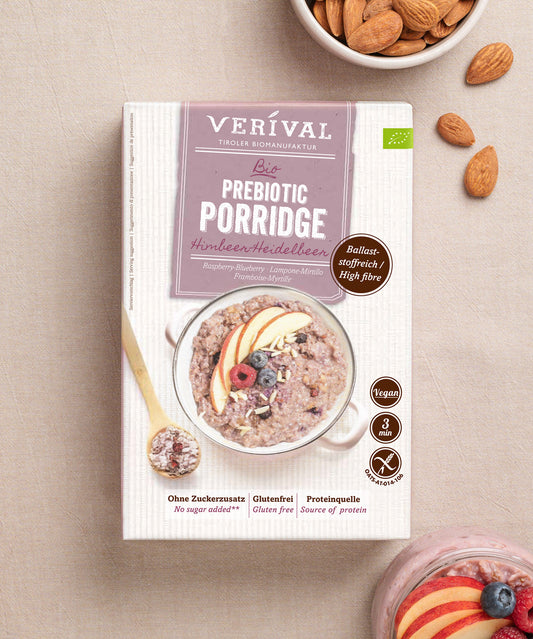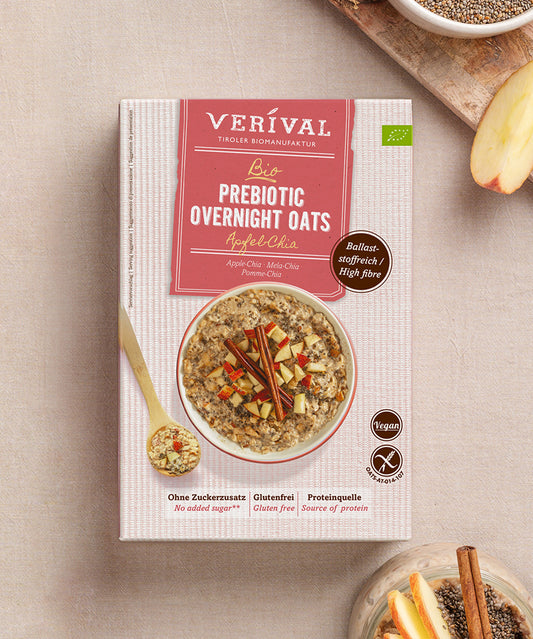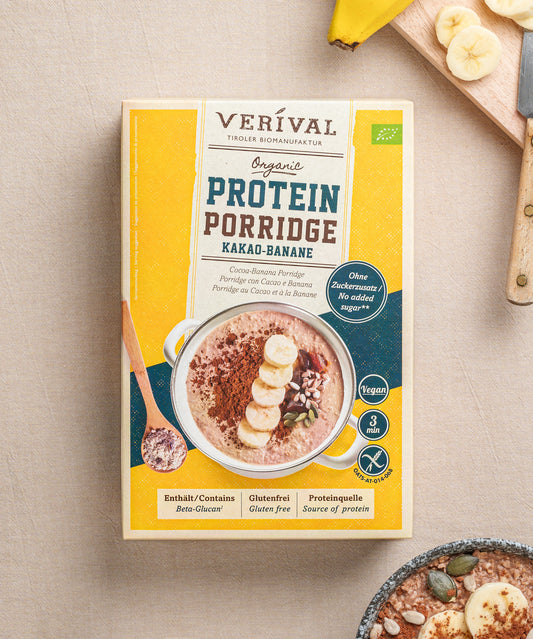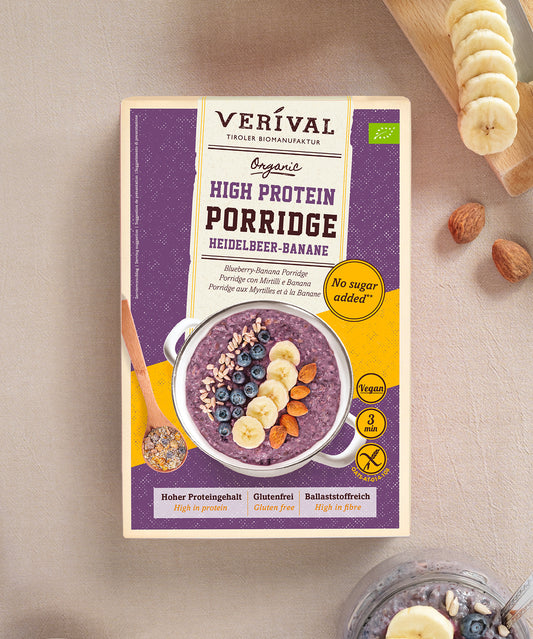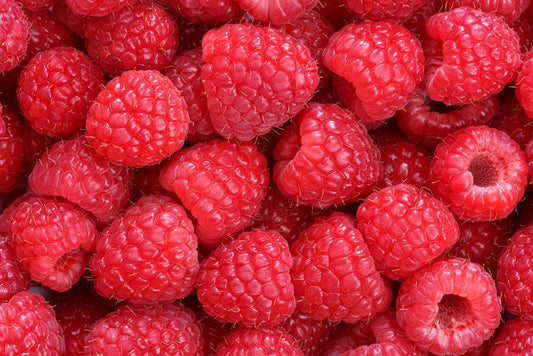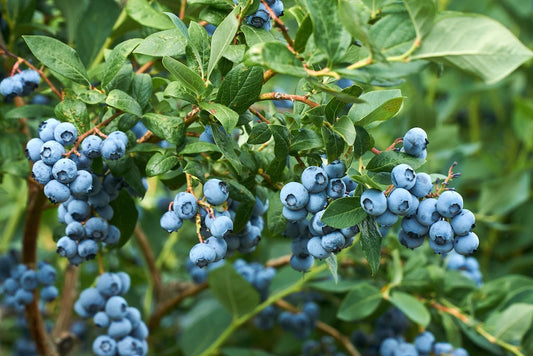Numerous myths have grown up around wheat as a food, because this widespread grain is supposedly unhealthy and even makes you fat.
It is not only said to cause digestive problems and associated abdominal pain because of the gluten it contains, but it is also suspected of promoting a wide range of diseases.
The grain has come under fire, particularly due to the boom in low-carb and gluten-free diets, and more and more people are now banning it from their diet.
Since wheat is consumed mainly as flour in bread, pastries and the like, this is also reflected in our breakfast preferences. In addition to wheat rolls, other types of grain are now also enjoying great popularity and variety is finding its way onto the breakfast tables of the world.
Discover the varied organic breakfast from VERIVAL
But what is actually behind the myths surrounding cereals? Here you can find out how unhealthy wheat really is:
Wheat: a staple food
Fresh bread rolls in the morning, pasta at lunchtime and a slice of bread with your evening meal – wheat is undisputedly considered a staple food and many people eat it several times a day. This is hardly surprising, as wheat, along with corn and rice, is one of the most widely grown cereals in the world.
In general, the grain is considered to be easy to digest. So if you have a sensitive stomach, wheat is a good choice.
Since wheat yields a particularly high harvest, the flour made from it is particularly popular for foods such as bread, pasta and cakes. To ensure the highest possible yield, conventional agriculture relies on so-called high-performance wheat.
However, since this high-yielding variety is also particularly susceptible to fungal infection, chemical sprays are regularly used to prevent this. In addition, the grain requires large amounts of water to thrive. Unfortunately, this makes high-yielding wheat an environmental offender.
In organic farming, on the other hand, more robust varieties of the popular grain are used and chemicals are largely avoided. This benefits not only our health but also the environment.
Wheat vs. other types of grain
If you look at the nutritional composition of the different types of grain, you can see that they all mainly consist of carbohydrates, contain little fat and provide a small amount of protein. This applies to ancient grains such as oats, spelt, rye and others as well as to wheat.
The following table provides an overview of the distribution of macronutrients in various types of grain per 100 grams:
| Calories | Carbohydrates | Protein | Fat | |
| Wheat | 326 kcal | 60 g | 11 g | 2g |
| Spelt | 331 kcal | 60 g | 14 g | 2g |
| Einkorn | 320 kcal | 62 g | 19 g | 3g |
| Bucket | 325 kcal | 62 g | 15 g | 3g |
| Oats | 351 kcal | 56 g | 11 g | 7 g |
| Barley | 334 kcal | 63 g | 10 g | 2g |
| Millet | 363 kcal | 69 g | 11 g | 4 g |
| Corn | 331 kcal | 65 g | 9 g | 4 g |
| Rye | 326 kcal | 61 g | 10 g | 2g |
| Rice | 351 kcal | 75 g | 9 g | 1g |
The table shows that there are no major differences in the calorie count or macronutrient distribution of the individual types of grain. So in this respect, it makes little difference whether you reach for wheat or opt for another type of grain.
In addition, grain contains important minerals such as magnesium, potassium and calcium, and the vitamins A, B1, B2, B6 and E. As a whole grain variant, grain also provides healthy fiber that not only aids digestion but also helps keep our blood sugar levels constant.
Health myths surrounding wheat
Wheat is considered by many to be an unhealthy fattening food, and since low carb has become trendy and gluten-free products have become increasingly popular, many people have given the widespread grain a wide berth.
Nowadays, mainly the ground grain in the form of wheat flour is used for all kinds of foods and dishes. Whole grain wheat in its original form is hardly used anymore. However, it is precisely this flour that has given wheat its bad reputation.
We have taken a closer look at two particularly persistent myths about the grain:
1. Wheat is unhealthy because it contains hardly any nutrients.
It's in every nutrition guide and is one of the top tips when it comes to eating healthier: white wheat flour should be replaced with the supposedly healthier whole grain at every opportunity.
But what is the difference? Both variants have the same amount of carbohydrates, yet whole grain flour is considered healthier. The reason for this is that while the shell of the grain is ground with the grain in the whole grain variant, it is removed during the milling process for the production of white flour. The shell contains a lot of healthy fiber. Together with these ingredients, the health benefits are also lost.
For example, fiber has a positive effect on digestion and also helps keep you feeling fuller for longer.
Important B vitamins and some minerals are almost exclusively found in the bran of the grain. White wheat flour is often said to contain empty calories that provide hardly any healthy nutrients.
So it is true that white flour offers fewer nutrients than the whole grain version, but it is wrong to make this claim about wheat per se.
2. Wheat can promote diabetes
As already mentioned, cereals in general are very carbohydrate-heavy. However, this is not a bad thing in itself. It only becomes unhealthy if you mainly consume “bad” or simple carbohydrates.
Unlike complex carbohydrates, they quickly enter the bloodstream and cause your blood sugar level to rise rapidly. As a result, your body releases insulin to normalize the sugar level in the blood.
Since the fiber-rich shell of whole wheat is removed in the case of white flour, the carbohydrates it contains are these simple and thus “bad” carbohydrates.
If you consume wheat flour or large amounts of other simple carbohydrates very often, causing your body to repeatedly release large amounts of insulin, your body develops insulin resistance and you become ill. This is called type 2 diabetes.
This means that wheat itself is not the problem here, but rather its processing into white flour and the excessive consumption of simple carbohydrates . Therefore, it is recommended to choose the whole grain version as often as possible to benefit from the health advantages of the grain.
Who wheat is actually unhealthy for
One reason why many people avoid wheat is the gluten it contains. This is a natural protein found in many types of grain. Since gluten intolerance, celiac disease and the like have been on everyone's lips, gluten is often blamed for digestive problems.
In people who actually suffer from such an allergy or intolerance, gluten can lead to inflammation in the intestines and thus cause abdominal pain. In the worst case, eating gluten-containing foods can lead to allergic reactions. Those affected should therefore avoid wheat or gluten-containing cereals in general or do without them altogether.
For all those who are not affected, gluten is, however, completely harmless and there is no reason to ban products containing gluten from your diet.
If you suspect that you may suffer from coeliac disease, gluten intolerance or gluten sensitivity, observe your cereal consumption and its effects. However, for a clear diagnosis, you should definitely see a doctor.
For those who are better off avoiding gluten, VERIVAL offers a wide range of delicious gluten-free breakfast products. Discover our gluten-free porridges and mueslis or try our gluten-free recipe tip:
The real problem: processed foods with wheat
Let's be clear: the wheat grain in its natural form is no healthier or unhealthier than other types of grain. The milling process to produce white flour does remove healthy nutrients from the wheat, but that doesn't make the flour unhealthy.
A major reason why a wheat-free diet is healthier is processed foods. Many of them contain wheat. So if you avoid wheat, and thus industrially processed products, you will benefit in terms of your health and probably even lose weight.
However, the problem here is not wheat, but the combination with sugar, fat and other flavor enhancers. When it comes to pizza, cakes, biscuits and the like, wholemeal or spelt flour is rarely used, giving the impression that wheat must be the cause of all evil.
Why you can enjoy wheat without concern
A closer look at the myths surrounding wheat shows that only processed foods that contain flavor-enhancing ingredients in addition to the grain actually harm our health.
Our tips are therefore:
- Consciously choose whole grain flour to benefit from the healthy ingredients of the grain.
- Cook and bake as often as possible yourself, because that way you decide what should go into your food and what shouldn't.
- Read the list of ingredients on food from the supermarket and stay away from products that contain a lot of sugar, unhealthy fats and flavor enhancers.
Discover VERIVAL breakfast made from natural ingredients in organic quality





